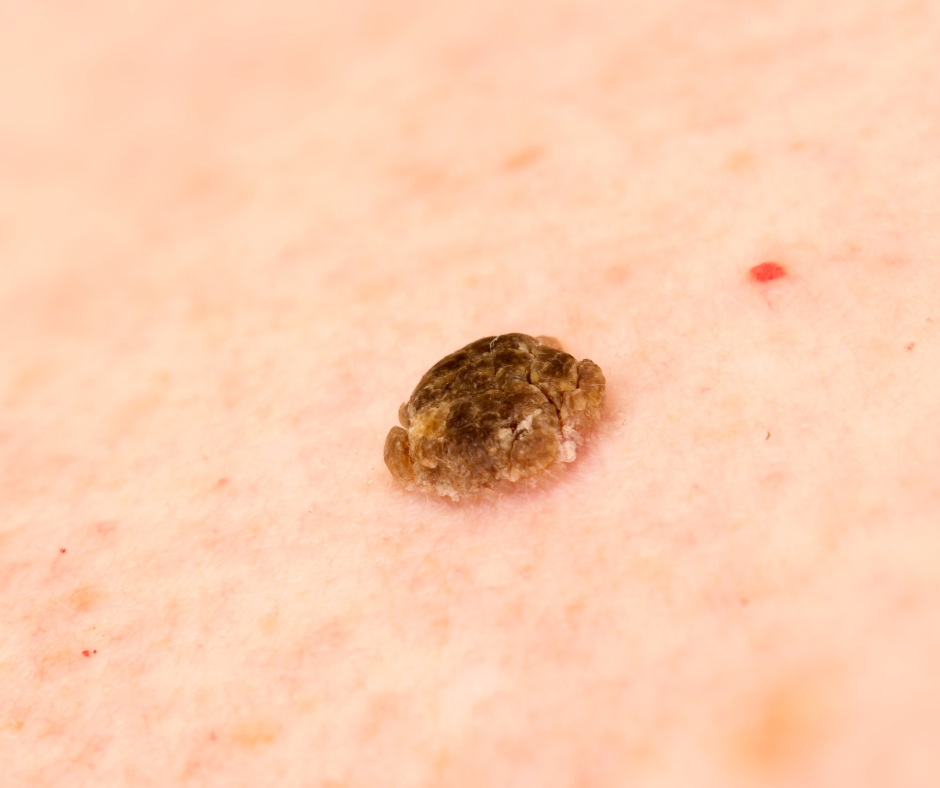If you have a light tan, brown, or black growth that is slightly raised, with either a waxy or rough texture – chances are it is a seborrhoeic keratosis.
These pesky skin lesions are prevalent in middle-aged and older adults and if you have one – the chances are high that you will develop more as you age (oh deep joy).
In this blog we explain what seborrhoeic keratoses are, why some people develop them, and how they can be easily and safely removed.
What is a seborrhoeic keratosis?
Seborrhoeic keratosis, also known as a senile wart or seborrhoeic wart, is a common non-cancerous skin growth that affects middle-aged and older adults. These growths can appear in different colors and sizes, often ranging from brown to black and may be flat or raised.
Seborrhoeic keratosis is often inherited and tends to increase in number as a person ages. Their exact cause is still not fully understood, but they are thought to be related to sun exposure, genetics, hormones, and age. While seborrhoeic keratosis is not a cause for concern, many individuals choose to have them removed for cosmetic reasons or if they become irritated or itchy.
They can occur anywhere on the body except for the palms of the hands and soles of the feet. While they are harmless, they can sometimes be unsightly and bothersome, leading many individuals to seek methods for removing them.
How to remove seborrhoeic keratosis
There are several different methods for removing seborrhoeic keratosis, including cryotherapy, curettage (scraping), laser therapy, and electrosurgery. Each method has its own set of benefits and risks, and the right method for removal will depend on the size, location, and number of seborrhoeic keratosis growths. Electrosurgery, in particular, has gained popularity as a safe and effective method for removing seborrhoeic keratosis and is our preferred method for removing them as it is quick to perform and leaves minimal scarring.
What is electrosurgery?
Electrosurgery is a minimally-invasive and non-surgical method for removing seborrhoeic keratosis and other skin imperfections such as moles, skin tags, and cherry spots. It uses a small probe with a tiny electrical current to target, destroy, and remove the skin lesion.
The practitioner uses a sterile probe to deliver a precise electrical current to the area, effectively shaving and removing the seborrhoeic keratosis from the surface of the skin. The procedure is relatively quick with little downtime. Most normal activities can resume immediately, but we advise patients to avoid physical activities such as going to the gym and swimming for around 48 hours until a good scab has formed to protect the area.
One of the main advantages of electrosurgery is its ability to target and remove seborrhoeic keratosis without causing damage to the surrounding healthy skin. This precision is especially important when dealing with growths on the face, neck, or other visible areas of the body.
After the treatment, individuals may experience some redness, swelling, or crusting in the treated area, but these side effects are typically mild and resolve within a few weeks as the treated area goes through a natural healing process. The skin may appear slightly darker before healing, but the discoloration will fade over time, leaving behind a smoother and more even skin texture.
It is important to note that while electrosurgery is a safe and effective method for removing seborrhoeic keratosis, it is crucial to have the procedure performed by a trained and certified practitioner. Choosing an experienced practitioner will ensure the treatment is conducted with the highest level of skill and precision, minimising the risk of complications and maximising the results.
Will my GP remove seborrhoeic keratosis?
As they are harmless, it is highly unlikely that National Health Services will remove them.
Typically, the National Health Service will only remove a lump or bump from the skin if it is deemed to be affecting physical or mental health. If it is considered to be a cosmetic problem, it is often suggested you make an appointment with a private GP to have it or them removed.
Always seek professional advice for any lumps, bumps or lesions you have – to make sure they are safe.
If you would like to know more about electrosurgery and our prices – please visit thefemalehealthclinic.co.uk/treatment/electrosurgery/
